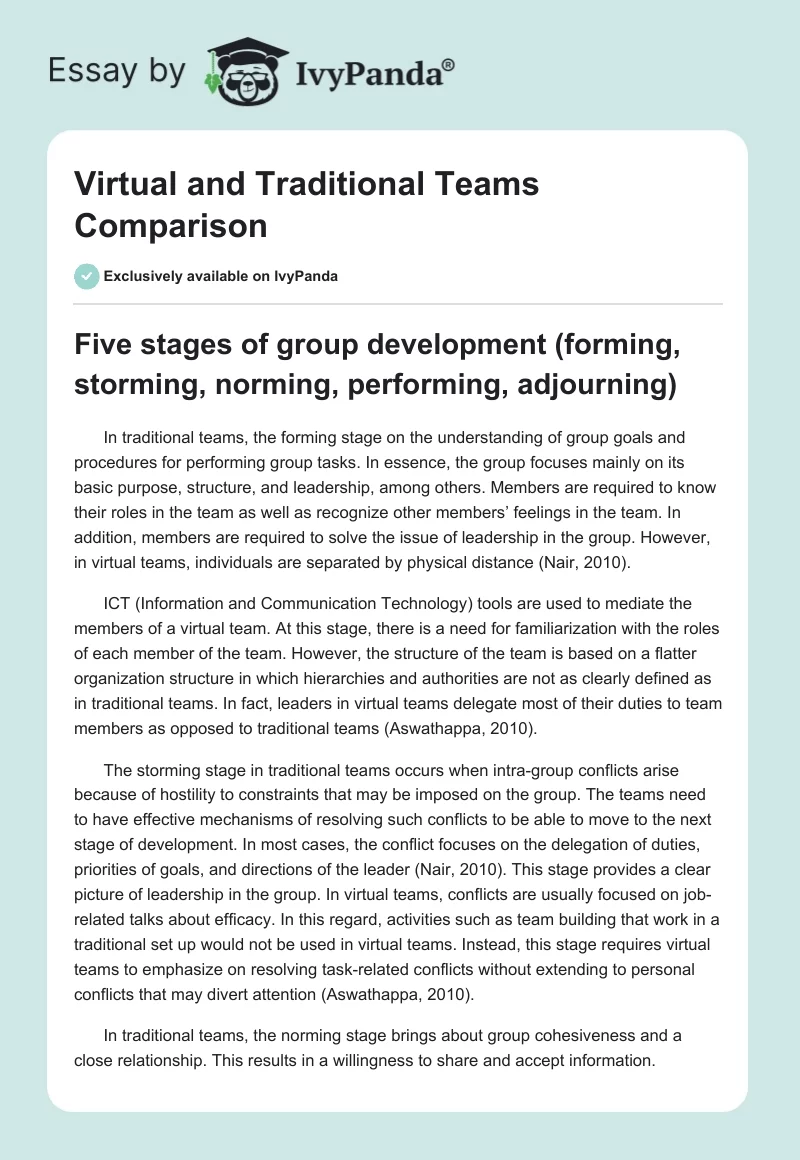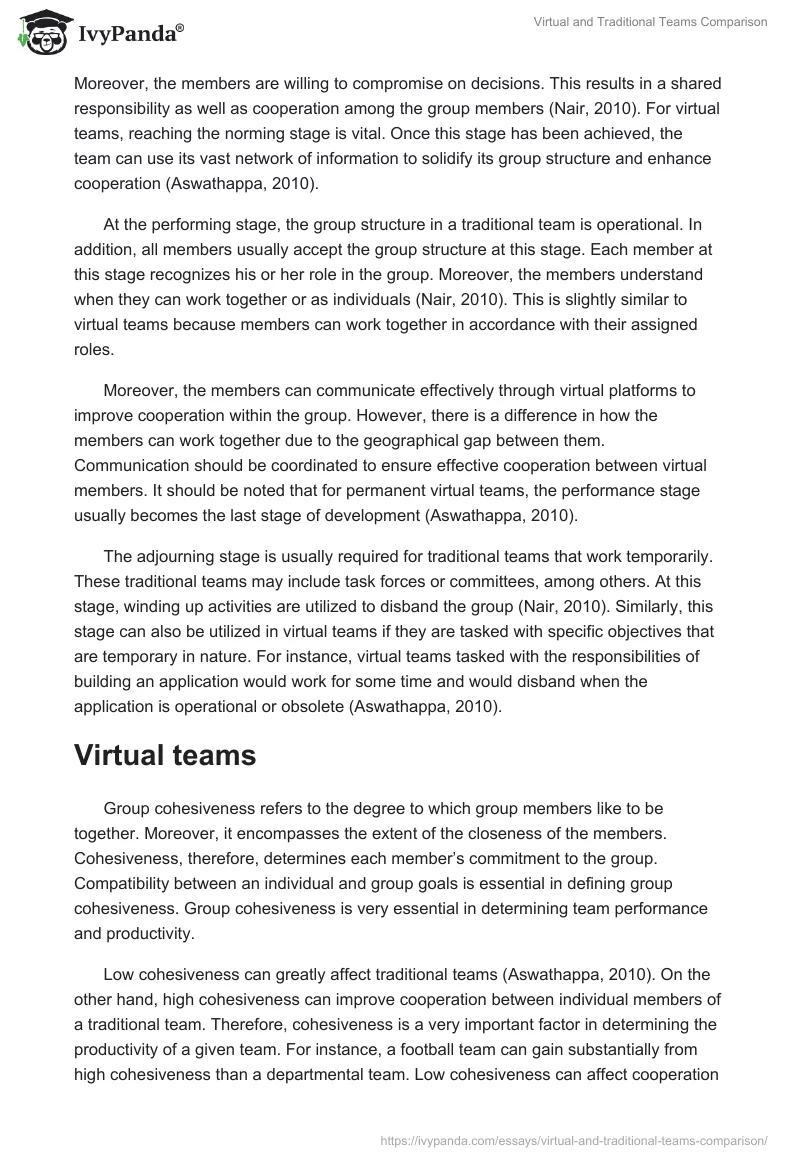Five stages of group development (forming, storming, norming, performing, adjourning)
In traditional teams, the forming stage on the understanding of group goals and procedures for performing group tasks. In essence, the group focuses mainly on its basic purpose, structure, and leadership, among others. Members are required to know their roles in the team as well as recognize other members’ feelings in the team. In addition, members are required to solve the issue of leadership in the group. However, in virtual teams, individuals are separated by physical distance (Nair, 2010).
ICT (Information and Communication Technology) tools are used to mediate the members of a virtual team. At this stage, there is a need for familiarization with the roles of each member of the team. However, the structure of the team is based on a flatter organization structure in which hierarchies and authorities are not as clearly defined as in traditional teams. In fact, leaders in virtual teams delegate most of their duties to team members as opposed to traditional teams (Aswathappa, 2010).
The storming stage in traditional teams occurs when intra-group conflicts arise because of hostility to constraints that may be imposed on the group. The teams need to have effective mechanisms of resolving such conflicts to be able to move to the next stage of development. In most cases, the conflict focuses on the delegation of duties, priorities of goals, and directions of the leader (Nair, 2010). This stage provides a clear picture of leadership in the group. In virtual teams, conflicts are usually focused on job-related talks about efficacy. In this regard, activities such as team building that work in a traditional set up would not be used in virtual teams. Instead, this stage requires virtual teams to emphasize on resolving task-related conflicts without extending to personal conflicts that may divert attention (Aswathappa, 2010).
In traditional teams, the norming stage brings about group cohesiveness and a close relationship. This results in a willingness to share and accept information. Moreover, the members are willing to compromise on decisions. This results in a shared responsibility as well as cooperation among the group members (Nair, 2010). For virtual teams, reaching the norming stage is vital. Once this stage has been achieved, the team can use its vast network of information to solidify its group structure and enhance cooperation (Aswathappa, 2010).
At the performing stage, the group structure in a traditional team is operational. In addition, all members usually accept the group structure at this stage. Each member at this stage recognizes his or her role in the group. Moreover, the members understand when they can work together or as individuals (Nair, 2010). This is slightly similar to virtual teams because members can work together in accordance with their assigned roles.
Moreover, the members can communicate effectively through virtual platforms to improve cooperation within the group. However, there is a difference in how the members can work together due to the geographical gap between them. Communication should be coordinated to ensure effective cooperation between virtual members. It should be noted that for permanent virtual teams, the performance stage usually becomes the last stage of development (Aswathappa, 2010).
The adjourning stage is usually required for traditional teams that work temporarily. These traditional teams may include task forces or committees, among others. At this stage, winding up activities are utilized to disband the group (Nair, 2010). Similarly, this stage can also be utilized in virtual teams if they are tasked with specific objectives that are temporary in nature. For instance, virtual teams tasked with the responsibilities of building an application would work for some time and would disband when the application is operational or obsolete (Aswathappa, 2010).
Virtual teams
Group cohesiveness refers to the degree to which group members like to be together. Moreover, it encompasses the extent of the closeness of the members. Cohesiveness, therefore, determines each member’s commitment to the group. Compatibility between an individual and group goals is essential in defining group cohesiveness. Group cohesiveness is very essential in determining team performance and productivity.
Low cohesiveness can greatly affect traditional teams (Aswathappa, 2010). On the other hand, high cohesiveness can improve cooperation between individual members of a traditional team. Therefore, cohesiveness is a very important factor in determining the productivity of a given team. For instance, a football team can gain substantially from high cohesiveness than a departmental team. Low cohesiveness can affect cooperation between members of the group. Nonetheless, groupthink can also interfere with the potential result of group cohesiveness. Groupthink can easily result in poor decision making when ineffective team decisions are agreed upon (Nair, 2010).
Based on the description of groupthink and its relation to cohesiveness, it is worth noting that virtual teams would be less cohesive than traditional teams. Virtual team members use ICT platforms, which are limited in their ability to produce a good interpersonal relationship between members. In fact, traditional teams tend to be more cohesive than virtual teams. For instance, football teams that have high cohesiveness tend to win more games than those that have low cohesiveness.
Traditional teams have better opportunities for promoting cohesiveness than virtual teams because they offer face-to-face interactions; this provides more insight into individual feelings than in virtual platforms (Wellington, 2012). However, it should also be noted that traditional teams are more culpable to groupthink than virtual teams. Virtual teams focus their attention on the tasks of the group than their interpersonal relations. On the other hand, traditional teams emphasize interpersonal relations that can result in groupthink (Sadri & Condia, 2012).
Virtual teams vs traditional teams
The virtual teams will perform better than traditional teams. However, this performance depends mainly on the type of goals intended for the team. If the goals require high cohesiveness, then traditional teams will outperform virtual teams. On the other hand, if high cohesiveness does not play a big role in the team, then virtual teams would always outperform traditional teams (Wellington, 2012). It should also be noted that where high cohesiveness is required, traditional teams would be vulnerable to groupthink. In this regard, traditional teams would only outperform virtual teams if the group guards on groupthink (Ferrazzi, 2012).
However, if all factors are managed, virtual teams have the capacity to outdo traditional teams. Virtual teams bring together skilled individuals from various parts of the world. These individuals have the expertise to achieve group goals; this gives them a better platform than traditional teams. Moreover, if the productivity of the group focuses on cost-effectiveness, then virtual teams would provide better results than traditional teams because of their ability to save time and resources (Narain, 2014).
In a global stage where technology is integrated into modern organizational management techniques, virtual teams have the capacity to improve further in achieving their goals than traditional teams. However, virtual teams should put their processes in place, communicate effectively, and focus conflicts on tasks to outperform traditional teams.
Reference List
Aswathappa, K. (2010). Organizational behavior. Mumbai, India: Himalaya Publishing House.
Ferrazzi, K. (2012). Virtual teams can outperform traditional teams. Web.
Nair, S.R. (2010). Organizational behavior. Mumbai, India: Himalaya Publishing House. pp. 271-298.
Narain, A. (2014). Are face-to-face teams more creative than virtual teams? Web.
Sadri, G., & Condia, J. (2012). Managing the virtual world. Industrial Management, 54(1), 21-25.
Wellington, P. (2012). Managing successful teams. London, England: Kogan Page Ltd.


